A wealthy, powerful country that is active on a global scale, Australia generally protects the rights of its children. In the largely homogeneous country, the majority of Australian children are offered the resources they need to succeed in education and to live healthy, safe lives. However, there is a huge amount of inequality in the nation, and for the minorities that live in Australia, as well as for children growing up in families of lower socio-economic status, Australia often fails to provide necessary services – especially in education.
 Vulnerable populations in Australia include children of Aboriginal and Torres Strait Islander background (Indigenous populations), rural children, children growing up in families of a lower socio-economic status, children with special education needs, and disabled children.
Vulnerable populations in Australia include children of Aboriginal and Torres Strait Islander background (Indigenous populations), rural children, children growing up in families of a lower socio-economic status, children with special education needs, and disabled children.
Indigenous populations
In 2010, there were 163,000 students of Aboriginal or Torres Strait Islander origin in Australian schools. This is a full 5% of the student population, although the percentage varies greatly between states or territories. Overall, children of Indigenous backgrounds perform much worse on educational assessments than those of British descent. For example, Australian Center for Educational Research (2013) found that on PISA exams “non-Indigenous students performed at a higher level on average than Indigenous students, by the equivalent of two-and-a-half years of schooling or more” in math, reading and science. These differences exist not just in education, but also in family life and health status. According to the Australian Research Alliance for Children and Youth, “indigenous young people have much higher rates of homelessness and living in overcrowded households.” Indigenous youth are more likely than their peers of European descent to live in poverty, and need extra support both in and out of the school setting. Indigenous children in Australia are six times more likely to be on care and protection.
 Fortunately, Australia has taken steps to alleviate this situation of inequality, particularly through strategies to engage Aboriginal and Torres Strait Islander students in school. Two philosophies lead this effort: the Circle of Courage program and the Stronger Smarter program. These two programs have a common goal of student engagement. The programs are certainly a good start to supplying Indigenous students extra support and helping them and the public to be aware that they are capable of the same outcomes as white students.
Fortunately, Australia has taken steps to alleviate this situation of inequality, particularly through strategies to engage Aboriginal and Torres Strait Islander students in school. Two philosophies lead this effort: the Circle of Courage program and the Stronger Smarter program. These two programs have a common goal of student engagement. The programs are certainly a good start to supplying Indigenous students extra support and helping them and the public to be aware that they are capable of the same outcomes as white students.
Rural children
Children living in rural areas of Australia may not live near health, education, or child services, putting them in danger of rights and needs not being met. Support for rural children who live in remote locations exists through student boarding facilities that are traditionally non-governmentally run, although government schools that serve rural populations do sometimes offer nearby residential hostels. Homeschooling is also an option in Australia, and can be complemented with virtual learning. To support these students further, remote community centers have been established in some states and territories. These facilities exist to assist in educating children and are staffed by specially trained employees.
Disabled children
Disabled students in Australia are also vulnerable and often disadvantaged. Anderson and Boyle (2015) point out that in Australia “there is no legislated ‘right’ to an education…or a ‘right’ for students to receive their education within a regular classroom.” Despite an estimated 12.3% of Australian students with additional educational needs, access to inclusive education is often denied to students with a disability. The Disability Discrimination Act of 1992 states that “it is unlawful for any person (including a child) to be discriminated against by an educational authority on the basis of a disability.” In 2005, the Disability Standards for Education declared that states must develop policies and programs to eliminate harassment and victimization of disabled students. Nevertheless, more and more, disabled students are segregated from other students, and there is a particular increase in indigenous enrollments in special education settings. These students are also less likely to move into higher education or find employment after completing secondary school. Despite moves to make schools in Australia more inclusive, there has been limited success.
Many children remain vulnerable, particularly children of indigenous backgrounds, children from rural families and disabled children. Australia must continue to provide for its vulnerable populations in both health and educational settings. Most importantly, the Commonwealth must address vulnerable populations who can not speak up for themselves.
Written by : Katie Krakow Proofread by: Denis Gingras |
Anderson, J., & Boyle, C. (2015). Inclusive education in Australia: Rhetoric, reality and the road ahead. Support for Learning, 30(1), 4-22.
Australian Bureau of Statistics. (2012). Year book Australia: Primary and secondary education. Retrieved from: http://www.abs.gov.au/ausstats/abs@.nsf/Lookup/by%20Subject/1301.0~2012~Main%20Features~Primary%20and%20secondary%20education~105
Australia Council for Educational Research. (2013). PISA 2012: How Australia measures up. Camberwell: Thomson, S., De Bortoli, L., Buckley, S. Retrieved from https://rd.acer.edu.au/article/pisa-2012-how-australia-measures-up
Australian Research Alliance for Children & Youth. (2013). Report card: The wellbeing of young Australians. Retrieved from http://www.aracy.org.au/documents/item/126
Law Library of Congress. (2007). Children’s rights: Australia. Washington, DC: White, L. Retrieved from: http://www.loc.gov/law/help/child-rights/australia.php
MacDougall, C., Riggs, E. & Lee, V. (2014). Writing a new story for Australia’s children. Australian and New Zealand Journal of Public Health, 28(3), 203-204.
Patton, G. C., Goldfeld, S. R., Pieris-Caldwell, I., Bryant, M. Vimpani, G. V. (2005). A picture of Australia’s children. Medical Journal of Australia, 182(9), 437-438.
Rauland, C., & Adams, T. (2015). A stronger, smarter future: Multicultural education in Australia. Reclaiming Children and Youth, 23(4), 30-35.

